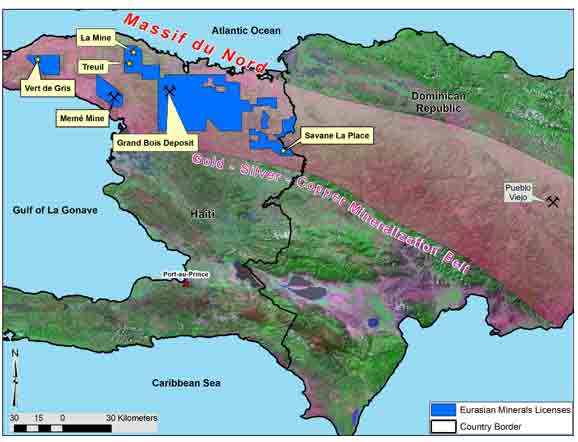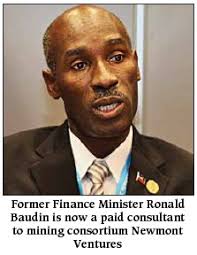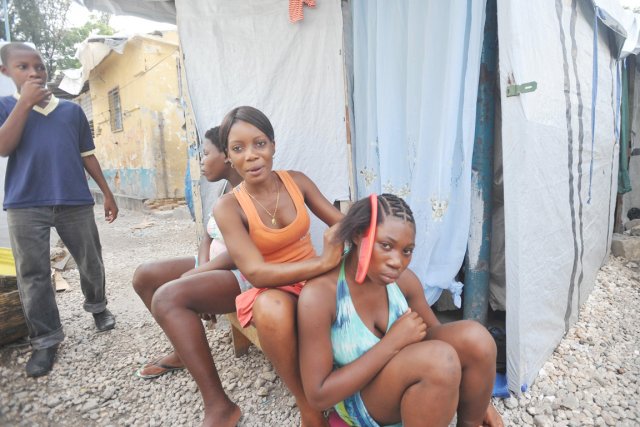Widgetized Section
Go to Admin » Appearance » Widgets » and move Gabfire Widget: Social into that MastheadOverlay zone
Haiti’s Gold Rush Promises El Dorado: But For Whom?
Partager/Share this

Backroom deals, legally questionable “memorandums”, and test drilling carried out with no public scrutiny and little government oversight are all part of the new gold rush in Haiti.
Twenty billion dollars worth of gold, copper and silver hidden in the hills of the hemisphere’s poorest country. Investors in North America convinced of the buried treasure, have already spent 30 million dollars collecting samples, digging, building mining roads and doing aerial surveys.
Twenty billion dollars worth of gold, copper and silver hidden in the hills of the hemisphere’s poorest country. Investors in North America convinced of the buried treasure, have already spent 30 million dollars collecting samples, digging, building mining roads and doing aerial surveys.
The fairy tale is true, but it might not have a “happily ever after” ending.
A 10-month investigation into Haiti’s budding “gold rush” by the watchdog consortium Haiti Grassroots Watch (HGW) discovered backroom deals, players with widely diverging objectives, legally questionable “memorandums”, and a playing field that is far from level.
Although Haitian law states that all subsoil resources belong to “the Haitian nation”, so far the nation has been kept in the dark about the digging and testing going on in the country’s north.

Dieuseul Anglade, a well-respected geologist who headed the state mining agency for most of the past 20 years, was recently fired by Haiti’s newly installed prime minister, Laurent Lamothe. Was it because he has consistently championed tougher laws and better deals for the state, and for the Haitian
?
?
“Minerals are part of the public domain of the state,” the 62-year-old Anglade told HGW a month before he was removed from his post.
The geologist said that if tougher laws and better contracts with the mining companies aren’t written, it would be better to “leave the minerals underground.”
Another major player in the gold game – Eurasian Minerals – has a different opinion of who should exploit Haiti’s riches.


Geologists and locals at Gran Bois gold prospect, Central Haiti.
The Canadian company and its Haitian subsidiaries are poised to mine on the very same ground where Christopher Columbus and the Spaniards once forced Haiti’s indigenous peoples to dig for gold.
Within 40 years of the famed 1492 landing, hard labor in the mines, murder and European diseases reduced the population from perhaps 300,000 to about 600.
Eurasian recently returned to the same hills where so many died, and has been quietly buying up licenses and conventions: 53 of them so far. The company controls exploration or exploitation rights to over one third of Haiti’s north.
Eurasian – which has tested over 44,000 samples so far – is partnered with the world’s number two gold producer, U.S.-based mining giant Newmont.
Another Canadian company, Majescor, and a small U.S. company, VCS Mining, and their subsidiaries have licenses or conventions for tracts totaling over 750 square kilometers.
Altogether, about 15 percent of Haiti’s territory is under license to North American mining firms and their partners.
As Majescor’s Haitian subsidiary said in a recent corporate presentation: Haiti is “the sleeping giant of the Caribbean!”
The giant was “asleep” because Haiti’s minerals have previously been too expensive to extract thanks to the tumult of the past three decades, characterized by brutal coups d’état, and due to local resistance to the mining companies.
But the price of gold has held steady above 1,500 dollars an ounce for the past year, Haiti hosts a U.N. peacekeeping force of 10,000 that will assure a modicum of security for the companies, and just next door in the Dominican Republic, foreign gold giants say they’ve found the largest gold reserve in the Americas: 24 million ounces.
In a nation where unemployment reaches 70 percent, where over half the population lives on less than a dollar a day, and where most of the government’s budget is covered by foreign aid, the buried treasure sounds like El Dorado.
But not all Haitians are as enthusiastic as the country’s leaders and foreign mining companies. Nor is it clear that the eventual revenues that might be generated would benefit Haiti and its people.
The mining companies estimate Haiti’s hills hold over 20 billion dollars in gold – much of it “invisible” because it exists in tiny particles in the rock and dirt. Extraction will only be possible with environmentally hazardous pit mines.
Pit mining can potentially poison water supplies and damage the environment.
Newmont Mining, Eurasian’s partner, knows its pits. The gold giant opened the world’s first pit mine in Nevada in 1962 and later dug in Ghana, New Zealand, Indonesia, and other countries. In Peru, Newmont runs one of the world’s largest open-pit gold mines: the 251-square-kilometer Yanacocha mine.
But even with its years of experience, the company’s track record is far from error-free.
In Peru, farmers’ organizations claim their water supply has been slowly polluted with cyanide, and in 2000, Newmont’s Peruvian trucking company spilled 330 pounds of mercury, causing dozens of people to become sickened with deadly diseases.
In Ghana, Newmont operates a mine located in a farming region known as Ghana’s “breadbasket”. So far, Ahafo South operations have displaced about 9,500 people, 95 percent of whom were subsistence farmers, according to Environmental News Service.
Newmont has poisoned local water supplies there at least once, by its own admission. In 2010, the company agreed to pay five million dollars in compensation for a 2009 cyanide spill.
In a May 25 email to HGW, Diane Reberger of Newmont wrote, “We can assure you that Newmont is committed to strong environment, social and ethical practices.”
Former state mining agency chief Anglade and other Haitian experts are worried that a pit mine could be dangerous to Haiti’s already fragile environment. Haiti has only about 1.5 percent tree cover, down from about 90 percent in 1492.
Haiti’s former environment minister Yves-André Wainright, an agronomist by training, noted that some of the areas under license are “humid mountains”, meaning they play “an important biodiversity role and need to be protected, starting in the prospection phase.” They are also home to tens of thousands of farming families.
“When I really think about the possibility of mining, I am not so sure it’s a good thing,” farmer and peasant organizer Elsie Florestan told HGW.
She and her family have some land near Grand Bois, where they grow corn, manioc and sweet potatoes and where Eurasian and Newmont just finished test drilling.
“They say the company will need to use the river water for 20 years, and that all the water will be polluted,” continued the 41-year-old member of Haiti’s Tèt Kole Ti Peyizan (“Small Peasants Working Together”) peasant movement. “They say we won’t be able to stay here.”
“If we don’t organize and make some noise, nothing good will happen as far as we are concerned,” she added.
Haiti has not signed the international Safety and Health in Mines Convention or the voluntary Extractive Industries Transparency Initiative, both of which – if followed – offer some protections. In addition, Haiti is ranked as one of the most corrupt countries in the world.
So far, permits have been issued behind closed doors, deals have been sealed secretly, and the test drilling has been carried out with no public scrutiny and little government oversight, by the state mining agency’s own admission.
“The government doesn’t give us the means we need to be able to supervise the companies,” Anglade confirmed in an interview while still head of the agency.
In addition, Haiti has one of the lowest royalty rates in the hemisphere, collecting only 2.5 percent of the value of each ounce of gold extracted. “A 2.5 percent royalty share is really low. Anything under five percent is just really ludicrous for a country like Haiti,” according to mining expert Claire Kumar of the humanitarian organization Christian Aid.
The mining companies also have friends in high places.

Former minister of finance Ronald Baudin – who sat across from Newmont at negotiating tables in 2010 and 2011 – went through the “revolving door” and now works as a consultant for Newmont-Eurasian. Asked in an interview with HGW about the apparent conflict of interest, the ex-minister said, “I have to eat, right?”
In March, Baudin helped facilitate a “Memorandum of Understanding” (MOU) he says allows Newmont to do test drilling. The ex-minister claims the MOU was “a waiver” to current law, which states that no drilling can take place without a signed mining convention.
Lawyers consulted by HGW confirmed that the only way to get around the requirements of a law is with a newer law that would remove the requirements of the old one.
Anglade, then head of the state mining agency, refused to sign the “waiver”. “I told them it was illegal and that it was not in Haiti’s interest,” Anglade said. Two months later he was out of a job.
Despite Anglade’s refusal to agree, the MOU was signed by the then-ministers of finance and of public works in late March. And on Apr. 23, Eurasian reported to its shareholders that it was “allowed to drill on certain selected projects” and that “drilling is currently underway.”
This article is a summary of an investigative series by Haiti Grassroots Watch (HGW) which can be read in full here (http://www.ayitikaleje.org/18_01_ENG). HGW is a partnership of AlterPresse, the Society of the Animation of Social Communication (SAKS), the Network of Women Community Radio Broadcasters (REFRAKA), community radio stations from the Association of Haitian Community Media and students from the Journalism Laboratory at the State University of Haiti. The Haitian weekly Haïti Liberté partnered with HGW on this report, which was made possible in part by a grant from the Pulitzer Center on Crisis Reporting.
Partager/Share this
























































